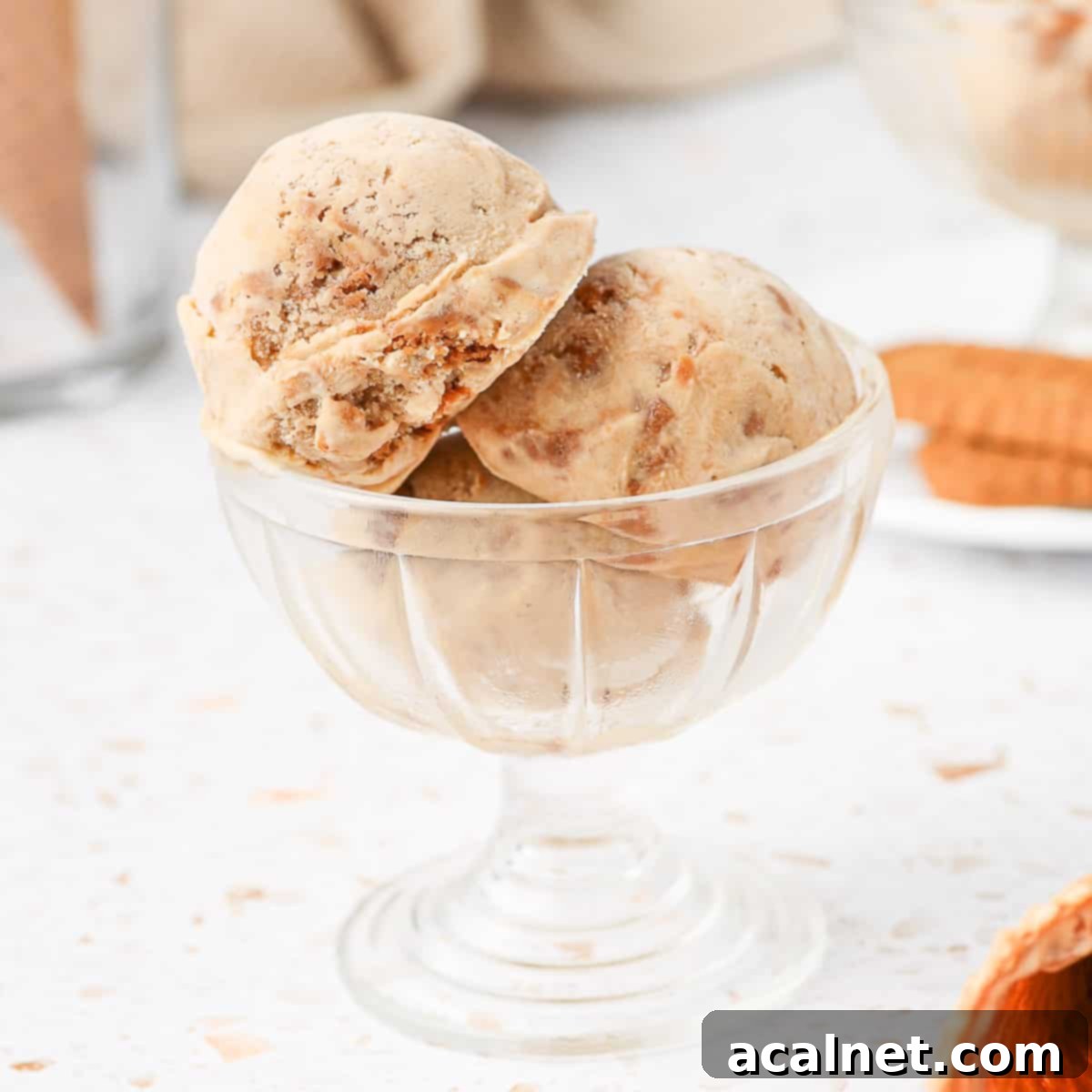Ultimate Homemade Biscoff Ice Cream: A Creamy Cookie Butter Dream
Welcome to the world of irresistible indulgence! This homemade Biscoff Ice Cream, affectionately known as Cookie Butter Ice Cream, is a true dream dessert for every Speculoos cookie and cookie butter enthusiast. Imagine a velvety, rich ice cream base infused with the distinctive caramelized spice notes of Biscoff, generously swirled with extra cookie butter spread and studded with crunchy Biscoff cookie crumbs. It’s a symphony of textures and flavors that will transport your taste buds straight to dessert heaven, making it an essential treat for any occasion, especially those warm summer days.
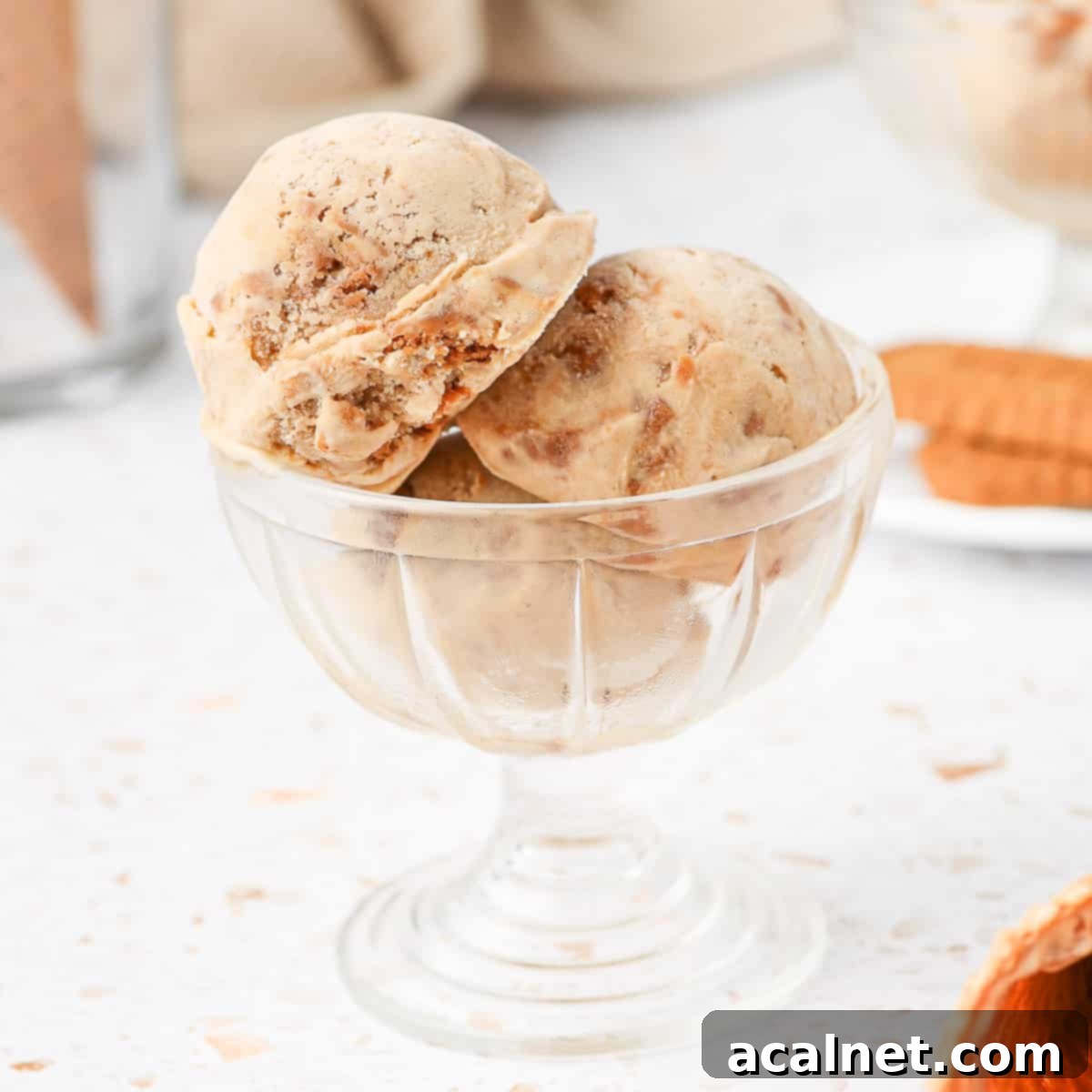
[feast_advanced_jump_to]
Why You’ll Fall in Love with This Biscoff Ice Cream Recipe
Prepare to be enchanted by the magic that happens when the iconic Lotus Biscoff cookie meets the rich, creamy texture of homemade ice cream. This isn’t just any frozen dessert; it’s a testament to the beloved Biscoff flavor, elevated into an unforgettable summer (or any season!) treat. What makes this particular recipe stand out?
- Unrivaled Flavor Fusion: We don’t just add Biscoff; we immerse the ice cream base in its unique spiced caramel notes, creating a deep, complex flavor that’s both sweet and subtly spiced.
- Dynamic Textures: Experience the luxurious creaminess of the churned ice cream perfectly contrasted with ribbons of smooth, luscious cookie butter swirl and delightful crunch from crushed Lotus Biscoff cookies. Every spoonful offers a new sensation.
- Decadent & Versatile: This original cookie butter ice cream is utterly delicious on its own, served in a cone, or as a show-stopping accompaniment. Imagine it melting gently over warm Biscoff Brownies, creating a truly epic dessert experience. It’s also fantastic with apple pie or simply enjoyed as a standalone treat.
- Homemade Goodness: There’s nothing quite like the satisfaction of making your own ice cream from scratch. You control the quality of ingredients, ensuring a fresh, pure taste far superior to most store-bought options.
- A Cookie Butter Lover’s Dream: If you adore Biscoff cookies or cookie butter spread, this recipe is designed specifically for you. It amplifies everything you love about Biscoff into a frozen, scoopable delight.
Discover More Irresistible Ice Cream Creations:
- Bright & Tangy Passion Fruit Ice Cream
- Luxurious Mascarpone Ice Cream
Essential Ingredients for Perfect Biscoff Ice Cream
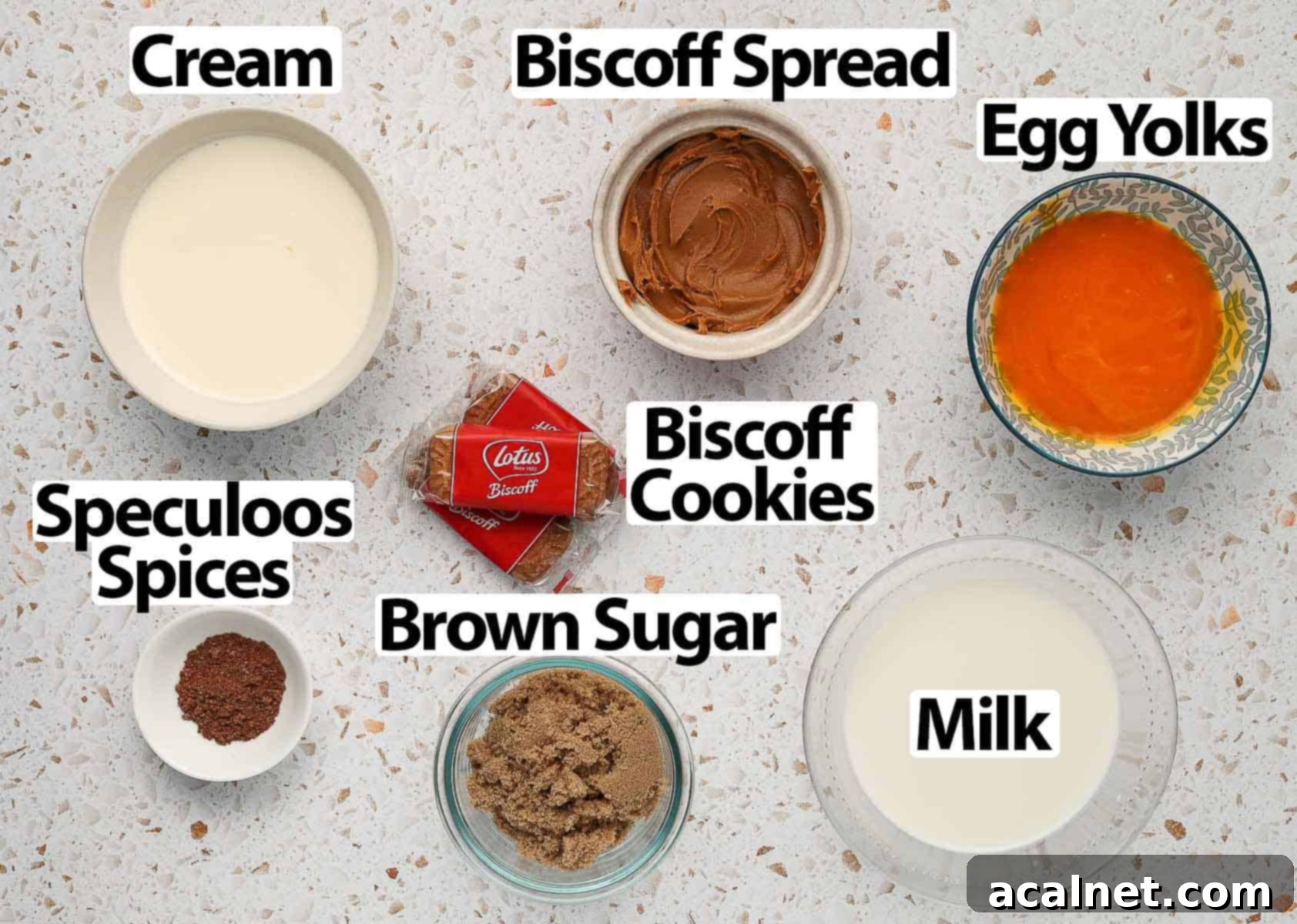
Crafting this phenomenal Biscoff Ice Cream requires a few key ingredients, each playing a vital role in achieving that signature creamy texture and distinct flavor. Here’s a detailed look at what you’ll need and why (for exact quantities, please refer to the recipe card below):
- Milk + Cream: For the ultimate creamy consistency, use Full Cream Milk (also known as Whole Milk, with approximately 3% milkfat) and Thickened / Heavy Cream (with a minimum fat content of 30%). The high fat content is absolutely crucial for preventing ice crystal formation and creating that incredibly smooth, luxurious mouthfeel that we all crave in homemade ice cream. Avoid skim milk or light cream; they simply won’t yield the desired rich, creamy texture.
- Egg Yolks: These are the stars of the classic ice cream custard base, often referred to as “crème anglaise.” Egg yolks provide incredible richness, act as a natural emulsifier, and contribute significantly to the thick, creamy, and velvety texture of the finished ice cream. They prevent the ice cream from becoming overly hard when frozen. There is no suitable egg substitute for this type of churned ice cream recipe if you want to achieve the authentic custard base.
- Brown Sugar: While white sugar can be used, brown sugar is highly recommended. It not only adds sweetness but also introduces subtle caramel notes that beautifully complement the spiced flavor of Biscoff. This extra layer of flavor contributes to the overall depth and complexity of the dessert.
- Biscoff Spread: Also known as cookie butter spread or Speculoos spread, this ingredient is the heart of our ice cream. We use it generously in two ways: first, it’s infused into the custard base, giving the entire ice cream a fundamental Biscoff flavor; second, it’s warmed and swirled into the churned ice cream, creating pockets of intense cookie butter goodness. Look for Lotus Biscoff Spread or any high-quality speculoos spread.
- Speculoos Spices: (Optional but highly recommended) This special blend of spices is what gives traditional Belgian Speculoos Cookies their distinctive aromatic flavor. Including it in your ice cream base will enhance the authentic Biscoff taste. You can find pre-made Speculoos spice mixes, or make your own. See the FAQs section below for more details on this unique spice blend and potential substitutions.
- Lotus Biscoff Cookies: These crunchy cookies are crumbled and folded into the ice cream to add a delightful textural contrast to the smooth, creamy base. They provide an extra layer of Biscoff flavor and a satisfying bite. You can use genuine Lotus Biscoff Cookies or any other brand of Speculoos Cookies.
Optional Additions: Consider adding a small pinch of salt to balance the sweetness and truly bring out all the flavors. A teaspoon of good quality Vanilla Extract can also enhance the overall aroma and taste profile, though Biscoff’s strong flavor often stands well on its own.
Crafting Your Homemade Cookie Butter Ice Cream: A Step-by-Step Guide
Making this incredibly delicious cookie butter ice cream is a rewarding process. Follow these detailed step-by-step instructions to create a creamy, flavorful frozen treat that will impress everyone.
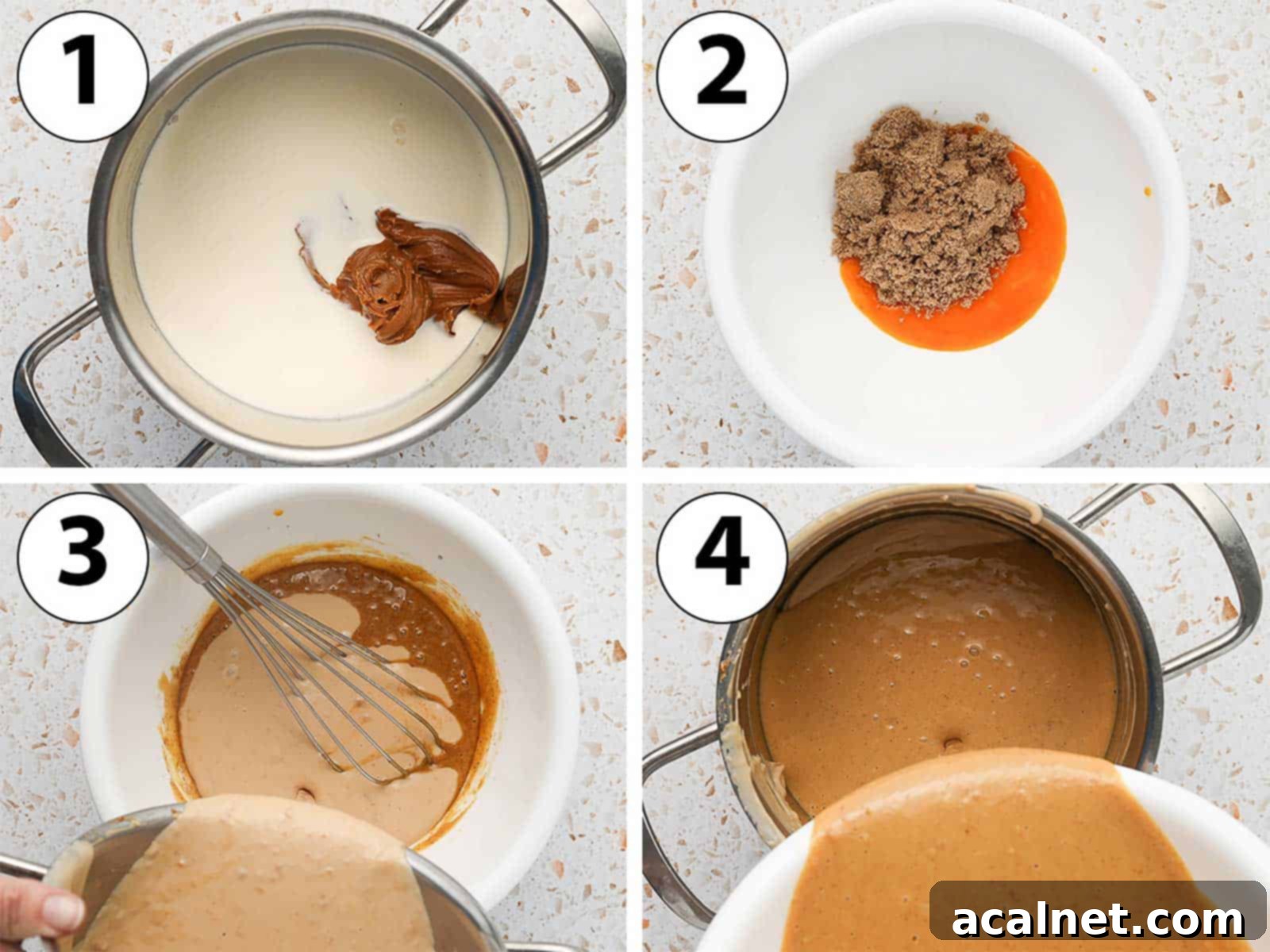
The foundation of this exceptional ice cream is a rich, creamy custard base. This classic “crème anglaise” is uniquely flavored with a generous addition of Lotus Biscoff cookie butter and, optionally, a touch of aromatic Speculoos spices.
Pro-Tip for Ice Cream Makers: Unless you are using a compressor ice cream maker (which chills its own bowl), it is absolutely essential to place the bowl of your machine in the freezer for at least 12 hours – and preferably 24 hours – before you plan to churn the ice cream. A thoroughly chilled bowl is key to achieving the right consistency. Always refer to your specific machine’s manufacturing instructions for optimal performance.
- Photo 1: Combine & Heat Wet Ingredients. In a small saucepan, combine the Milk, Cream, and Biscoff Spread/Cookie Butter Spread. Place the saucepan over low heat and gently bring the mixture to a simmer. It’s crucial to whisk continuously or at least very frequently to ensure the Biscoff spread fully melts and incorporates smoothly into the liquids, and to prevent it from sticking or burning at the bottom of the pan.
- Photo 2: Prepare Egg Mixture. While the milk mixture is heating, take a separate, heat-proof bowl. Whisk together the Egg Yolks, Brown Sugar, and the optional Speculoos Spices until the mixture is light in color and slightly fluffy. This process is essential for incorporating air and preparing the yolks to receive the warm liquid.
- Photo 3: Temper the Eggs. This is a crucial step to prevent your eggs from curdling! Once the milk mixture reaches a gentle simmer, slowly pour about a third of the warm liquid over the egg yolk mixture in a thin stream, whisking vigorously and continuously. Keep whisking until everything is well combined and smooth. This gradual addition of warm liquid raises the temperature of the egg yolks slowly, tempering them so they don’t scramble when returned to the hot saucepan.
- Photo 4: Return to Pan. Pour the entire tempered egg and milk mixture back into the original saucepan.
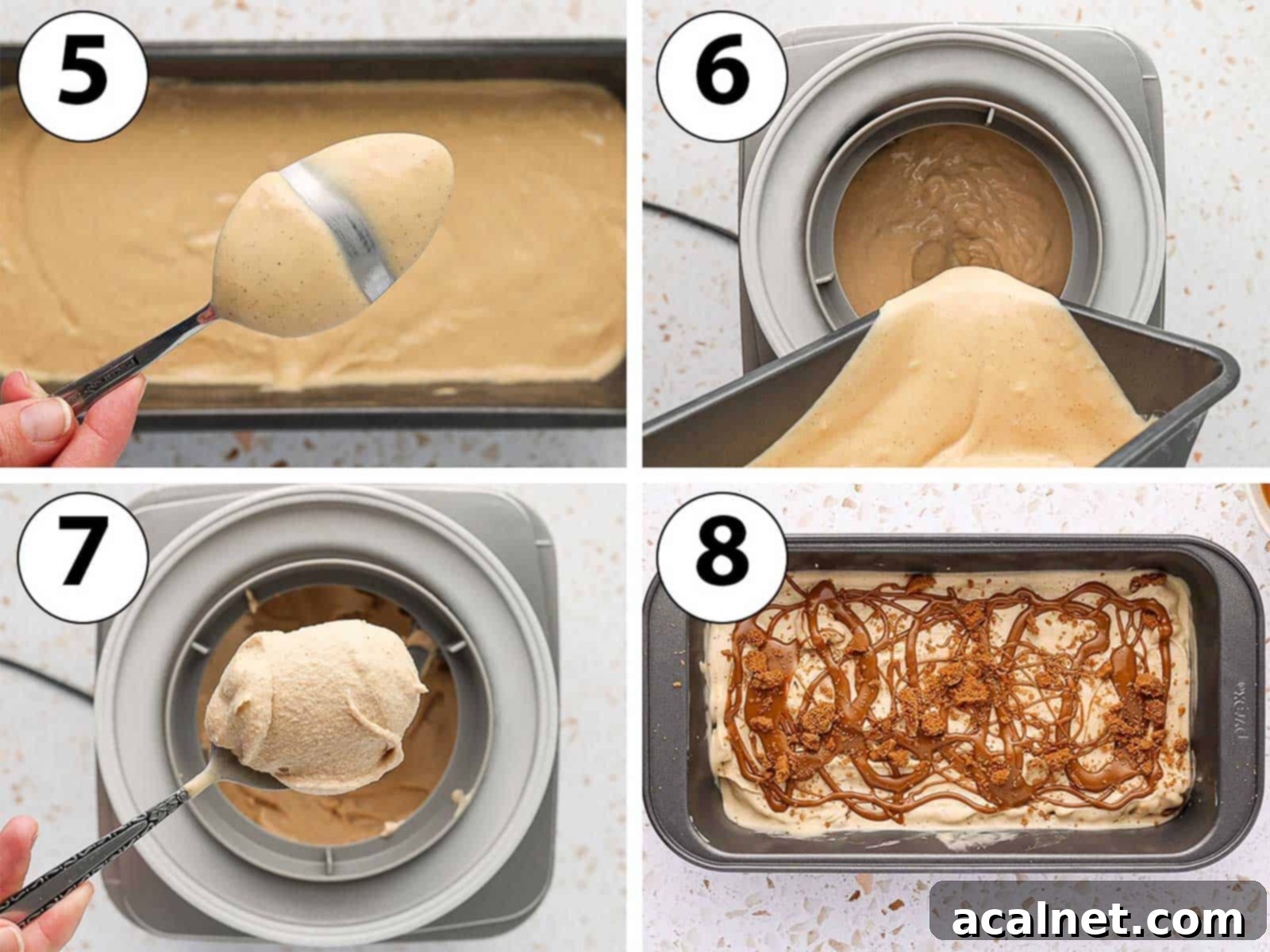
- Photo 5: Cook the Custard. Continue to cook the mixture over low to medium-low heat for 5 to 10 minutes, stirring constantly with a whisk or a rubber spatula. The goal is for the custard to slightly thicken, reaching a consistency that coats the back of a spoon. Do not boil the mixture, as this can cause the eggs to curdle.
There are two reliable methods to confirm your custard is perfectly cooked and ready for chilling:
- Temperature Check: Use a reliable kitchen thermometer. The custard is perfectly cooked when it reaches a temperature between 82 to 84 degrees Celsius (180 to 183 degrees Fahrenheit). This temperature ensures the eggs are safely cooked without overcooking.
- Spoon Test (Nappe Test): Dip the back of a clean spoon into the mixture. Carefully run your finger across the back of the spoon, drawing a line (be cautious, it will be hot!). If the line remains clear and the custard does not run back together, it has reached the ideal “nappe” consistency and is ready. If the custard is still too thin and runs over the line, continue cooking for a few more minutes, stirring constantly, and retest.
- Chill the Custard. Once cooked, immediately pour the custard mixture into a clean bowl or a large shallow container, such as a brownie pan or a wide loaf pan. Shallow containers help the mixture cool down more quickly and evenly. Cover the surface of the custard directly with plastic wrap, pressing it down so it touches the entire surface. This prevents a skin from forming. Chill in the refrigerator for at least 3 hours, but ideally overnight, until it is thoroughly cold. A well-chilled custard is essential for proper churning.
Note: If you are fortunate enough to have a compressor ice cream maker, you can churn the ice cream base immediately after it cools down to room temperature, skipping the extended refrigeration time.
- Photo 6: Churn the Ice Cream. Take your ice cream machine’s frozen bowl out of the freezer and carefully fit it into your ice cream maker according to the manufacturer’s instructions. Pour the thoroughly chilled custard mixture into the bowl and turn on the machine.
For consistently delicious results, I rely on my trusty Cuisinart Ice Cream Maker for all my homemade ice cream recipes. It’s a real workhorse!
- Photo 7: Monitor Churning. Churn the mixture for approximately 10 to 15 minutes. The churning time can vary depending on your machine and the exact temperature of your custard. You’re looking for a consistency that resembles thick whipped cream or soft-serve ice cream. It should be noticeably thicker and lighter than the original liquid, though you might still see small ice crystals—this is perfectly normal at this stage.
Due to the high fat content in Biscoff spread, this ice cream base tends to churn and harden more quickly than traditional ice creams. Be mindful not to over-churn; if you do, the ice cream may become excessively thick and hard, and in extreme cases, the cream can start to separate and take on a slightly greasy texture, akin to butter.
- Photo 8: Assemble the Swirl & Freeze. Once churned to the soft-serve consistency, transfer about half of the soft ice cream into a large loaf pan or an airtight freezer-safe container. Drizzle half of the warmed cookie butter (reserved for the swirl) over the ice cream layer, and then sprinkle half of your crushed Speculoos/Biscoff cookie crumbs. Carefully add the remaining ice cream on top, followed by the second half of the Biscoff spread drizzle and cookie crumbs. Using a small knife or a skewer, gently swirl all the ingredients together to create beautiful, enticing ribbons of cookie butter and cookie pieces throughout the ice cream.
- Final Freeze. Cover the loaf pan or container tightly with plastic wrap or a lid, ensuring it’s as airtight as possible to prevent freezer burn. Place it back into the freezer for at least 3 to 4 hours, or until the ice cream is firm enough to scoop perfectly. For an extra touch of indulgence when serving, you can optionally drizzle with more melted cookie butter!
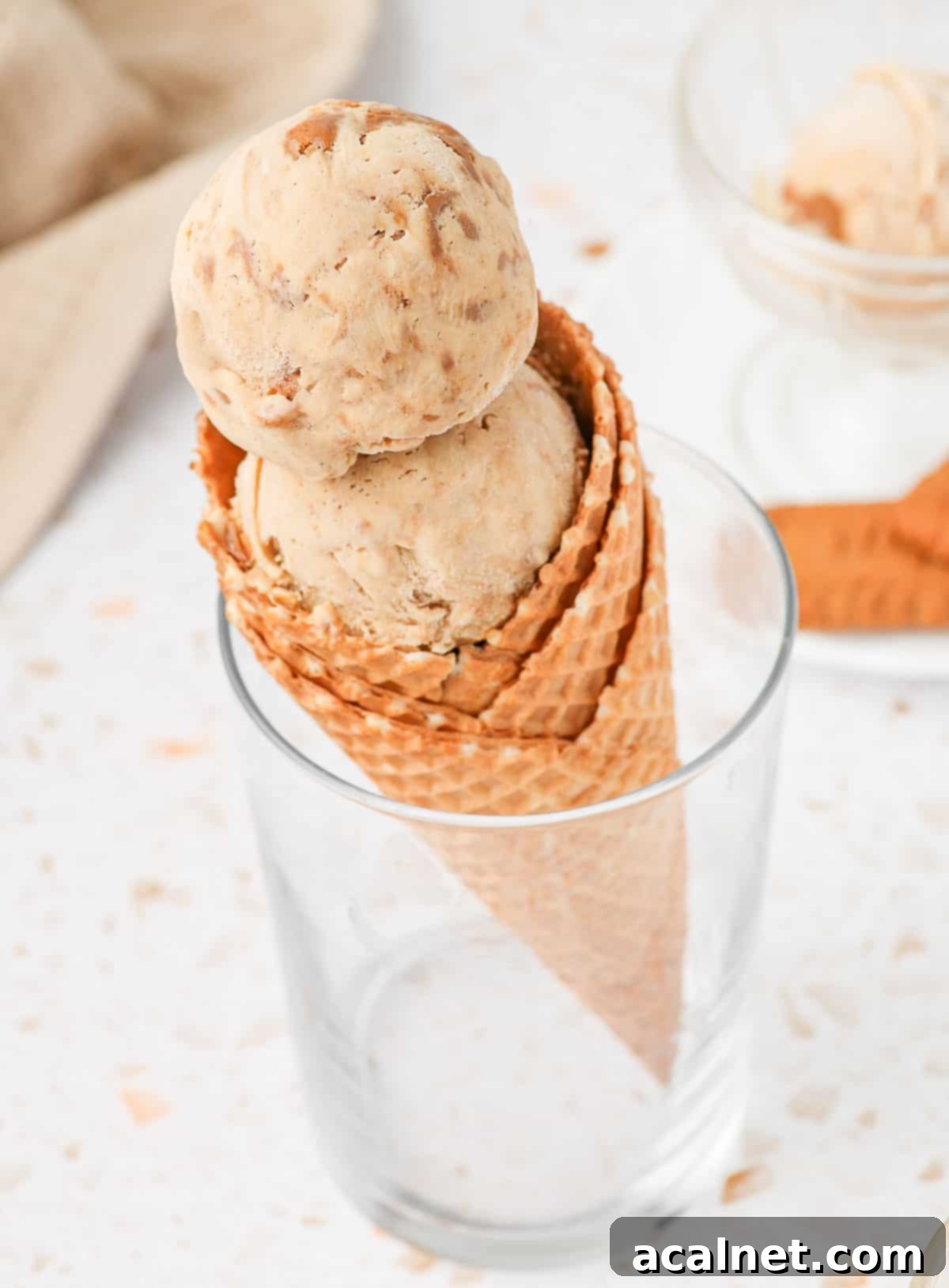
Frequently Asked Questions About Biscoff Ice Cream
Unfortunately, no, this particular recipe is not designed as a “no-churn” ice cream. The process relies on an ice cream maker to continuously churn and incorporate air into the custard base as it freezes. This churning action is essential for breaking down ice crystals and creating the smooth, creamy, and soft texture that is characteristic of traditional custard-based ice cream. Without an ice cream maker, the mixture would likely freeze into a solid, icy block rather than a scoopable, velvety dessert. For no-churn recipes, the base typically contains condensed milk and whipped cream, which emulsify without churning.
Speculoos spice mix is a distinct blend of warming spices traditionally used to flavor Belgian Speculoos Cookies. While the exact proportions can vary slightly between brands or family recipes, it typically includes Cinnamon, Coriander Seed, Nutmeg, Ginger, Caraway Seed, and Cloves. This combination gives Speculoos its signature complex, aromatic, and slightly peppery-sweet profile.
If you can’t find a pre-made Speculoos spice mix, you have a couple of good options for substitution:
- Mixed Spices: In many countries, a “mixed spice” blend is available which often contains a similar array of warming spices and can serve as a decent alternative.
- Pumpkin Pie Spice: This American spice blend is also relatively close in flavor profile, primarily featuring cinnamon, nutmeg, ginger, and cloves, making it a viable stand-in.
- Discard Spices: If you prefer to keep things simple or don’t have these blends, you can simply omit the spices altogether. The Biscoff spread itself carries a lot of the characteristic flavor.
I do not recommend using just Cinnamon as a direct replacement. While cinnamon is a major component, Speculoos spice offers a much deeper, more nuanced, and complex flavor profile that cinnamon alone cannot replicate. Using a broader mix will give you a closer approximation to the authentic Biscoff taste.
Speculoos are traditional Belgian spiced shortbread cookies, renowned for their delicate crunch and unique caramelized flavor. Historically, they were baked and enjoyed around Christmas time, particularly on St. Nicholas Day (December 6th) in Belgium and the Netherlands. Each cookie typically features an intricate design, often depicting figures or scenes from folklore.
Biscoff is essentially a brand name for Speculoos cookies. The Belgian company Lotus Bakeries popularized these cookies globally under the registered trademark “Lotus Biscoff.” The name “Biscoff” itself is a portmanteau of “biscuit” and “coffee,” highlighting their perfect pairing with a cup of coffee. So, while all Biscoff cookies are Speculoos, not all Speculoos cookies are necessarily Biscoff brand.
In culinary terms, Biscoff Spread and Cookie Butter are essentially the same product, made from finely crushed Speculoos (Biscoff) cookie crumbs, blended with various fats (like vegetable oils), flour, and sugar to create a smooth, spreadable consistency.
The primary difference lies in branding and regional naming. “Biscoff Spread” is the specific name used by Lotus Bakeries for their version, which directly uses their famous Lotus Biscoff cookies. “Cookie Butter” is a more generic term used by other brands that produce a similar spread using their own Speculoos-style cookies.
For baking purposes, including this ice cream recipe, you can generally interchange Biscoff Spread and any generic cookie butter spread. While minor differences in spice blend or sweetness might exist between brands, they will yield very similar delicious results in your finished dessert.
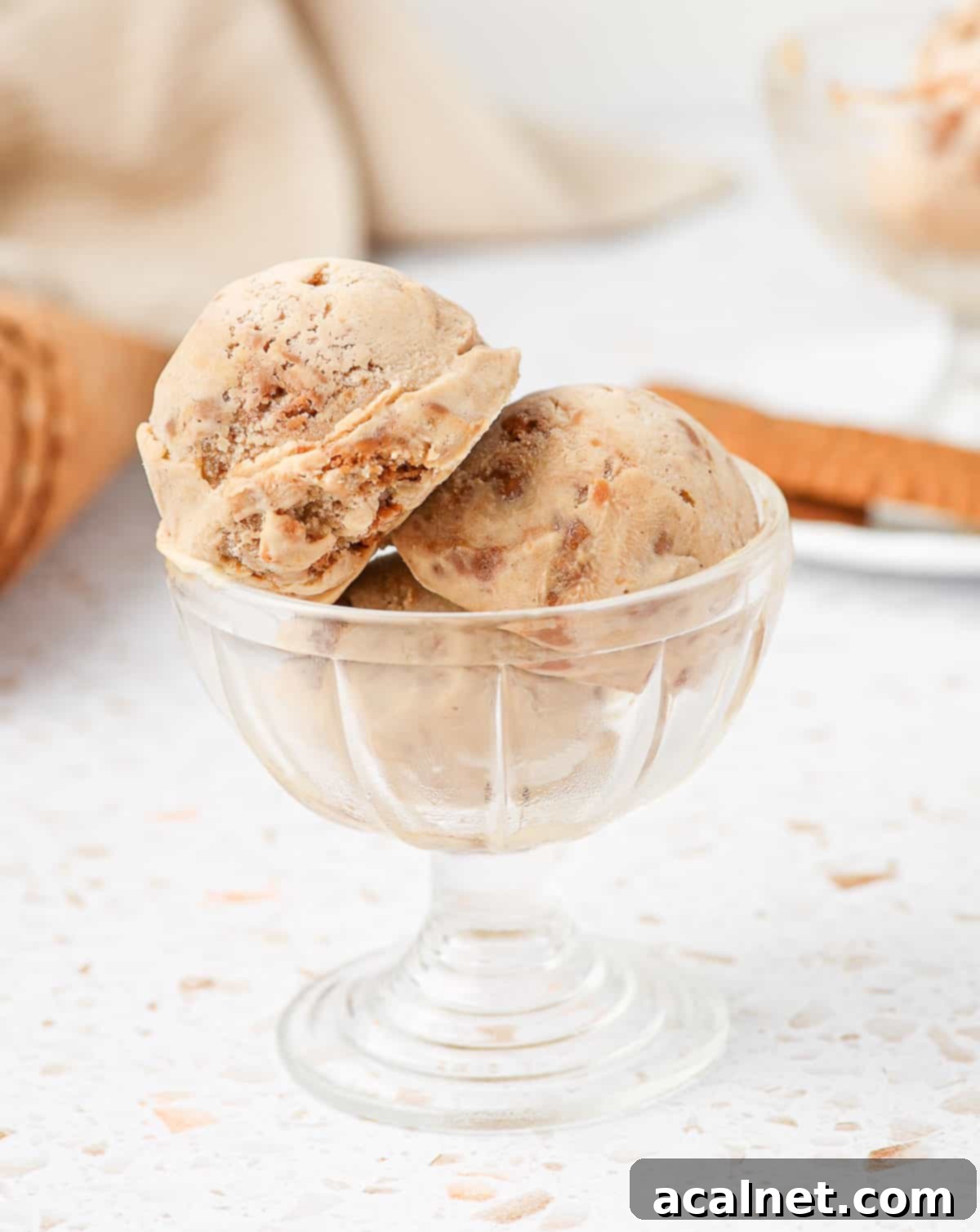
Key Tips for Perfect Homemade Biscoff Ice Cream
Achieving a perfectly creamy and delicious homemade Biscoff Ice Cream is simple if you follow these expert tips:
- Smooth Custard is Key: If you notice your Biscoff custard base has small lumps, it’s likely a sign that the egg yolks might have cooked too quickly or at too high a temperature, leading to tiny bits of scrambled egg. Don’t despair! You can salvage the custard by carefully pouring it through a fine-mesh sieve or strainer to remove any unwanted cooked egg pieces before chilling.
- Mastering Custard Doneness: To be sure your custard base is cooked to perfection, always use a reliable kitchen thermometer. It should register between 82°C (180°F) and 84°C (183°F). Alternatively, perform the classic “spoon test”: dip the back of a spoon into the custard, run your finger across it, and if the line holds clear without the custard running back together, it’s ready. This consistency means it will properly coat the back of the spoon without dripping.
- Optimal Chilling for Best Results: Thoroughly chilling your custard mixture before churning is paramount. I highly recommend refrigerating it overnight to ensure it’s ice-cold. For an even better outcome, place the chilled custard in the freezer for about 20-30 minutes just before pouring it into the ice cream machine. Colder custard freezes faster and results in a smoother, creamier ice cream with smaller ice crystals.
- Beware of Over-Churning: This Biscoff ice cream recipe tends to churn a bit more quickly than some other homemade ice cream varieties. This is largely due to the high fat content present in the Biscoff spread, which solidifies rapidly. Be attentive during the churning process. If you over-churn, the ice cream can become excessively thick and hard, almost like frozen butter. In extreme cases, the fat can start to separate, giving the ice cream a slightly greasy, unpleasant consistency. Stop churning when it reaches the consistency of soft-serve.
Storing Your Homemade Biscoff Ice Cream
While this delightful cookie butter ice cream will remain safe to eat for an extended period in the freezer, its consistency and texture are at their absolute best when enjoyed fresh within a few days, ideally up to a week. Over time, as it stays longer in the freezer, the ice cream can gradually develop a more rough and icy texture, which is a common characteristic of homemade ice creams due to less air incorporation and the lack of commercial stabilizers found in store-bought varieties. For optimal storage, transfer the churned and swirled ice cream into an airtight freezer-safe container, pressing a piece of plastic wrap directly onto the surface before sealing with a lid. This helps to minimize exposure to air and reduce ice crystal formation, preserving its creamy quality for as long as possible.
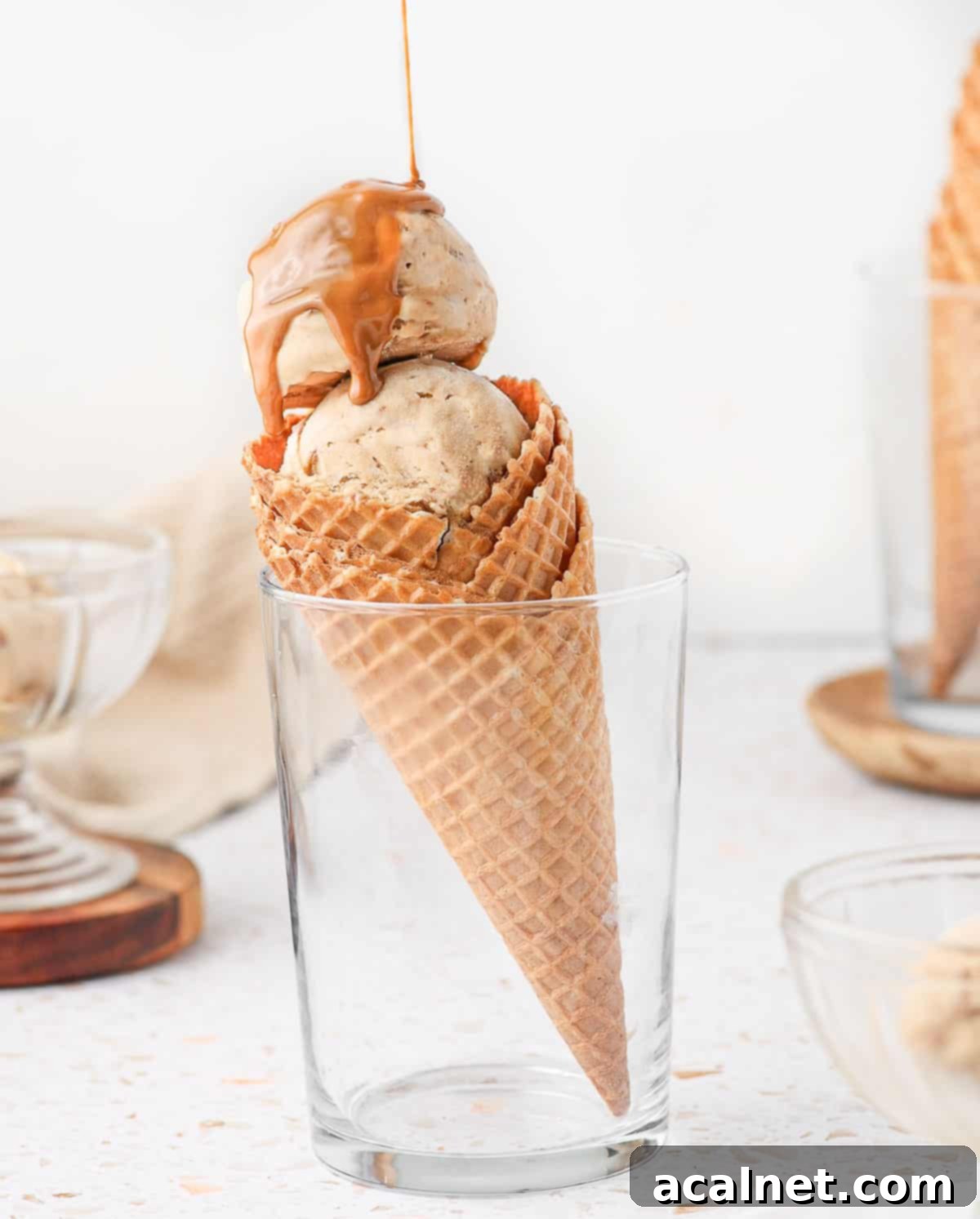
Explore More Delicious Biscoff Recipes
Can’t get enough of that incredible spiced cookie flavor? Biscoff spread and cookies are incredibly versatile and can elevate a multitude of desserts. If you’ve loved this Biscoff ice cream, you’re sure to enjoy these other delightful Biscoff-inspired creations from our kitchen. Expand your baking repertoire and indulge in more cookie butter goodness!
- Decadent Biscoff Truffles
- Easy & Moist Biscoff Cake
- Creamy Speculoos Tiramisu
- Rich Baked Biscoff Cheesecake
- Buttery Biscoff Butter Cookies
- Adorable Mini Biscoff Cheesecakes
- Dreamy Cookie Butter Cream Cheese Frosting
- Irresistible Biscoff Cupcakes
- Effortless No Bake Biscoff Cheesecake
- 12 Must-Try Delicious Recipes with Biscoff Spread
Made this recipe?
We’d love to hear from you! Let us know if you liked it by leaving a comment below, and be sure to tag us on Instagram @a.baking.journey with a photo of your delicious Biscoff Ice Cream creation!
Full Recipe Details

Biscoff Cookie Butter Ice Cream
Print Recipe
Equipment
- Ice Cream Maker
Ingredients
Biscoff Ice Cream
- 360 ml (1 1/2 cup) Full Cream / Whole Milk
- 240 ml (1 cup) Heavy / Thickened Cream
- 60 gr (1/4 cup) Biscoff Spread, or cookie butter spread
- 4 Egg Yolks, medium, at room temperature
- 50 gr (1/4 cup) Brown Sugar
- 1 teaspoon Speculoos Spices (optional), (see notes below for substitute)
Crunchy Biscoff Swirl
- 120 gr (1/2 cup) Biscoff Spread, or cookie butter spread
- 6 Biscoff Cookies, or to taste
Instructions
- Unless using a compressor ice cream maker, it is recommended to put the bowl of your machine in the freezer at least 12 hours (preferably 24 hours) before churning the ice cream. Always follow the manufacturing instructions of your specific machine.
Biscoff Ice Cream
- Place the Milk, Cream and Biscoff Spread in a small saucepan. Turn on low heat and bring to a simmer, occasionally whisking to avoid burning the spread.
- While it is heating up, whisk together the Egg Yolks, Brown Sugar and Speculoos Spices (optional) in a separate heat-proof bowl.
- When it starts to simmer, pour the warm mixture over the yolks/ sugar while whisking. Whisk well to combine until no lumps remain (see note 1).
- Pour the whole mixture back into the saucepan and cook on low to medium low heat for 5 to 10 minutes while stirring, or until it starts to slightly thicken (see note 2).
- Transfer the mixture into a clean bowl or large shallow container (see note 3) and cover with plastic wrap touching its surface. Chill in the fridge for at least 3 hours – preferably overnight.
- Take the bowl of your ice cream machine out of the freezer and fit it in the ice cream maker. Pour the cool custard mixture into the bowl and churn for 10 to 15 minutes, or until it resembles the consistency of a thick whipped cream (see note 4).
Crunchy Biscoff Swirl
- Place about half of the ice cream in a large clean loaf pan. Drizzle with half of the melted cookie butter and half biscoff cookie crumbs. Top with the rest of the ice cream then the rest of the biscoff spread and crumbs. With a small knife, swirl all the ingredients together.
- Place back in the freezer for at least 3 to 4 hours – or until the ice cream is firm enough to scoop up.
Would you like to save this recipe?
We’ll email this post to you, so you can come back to it later!
Notes
- Speculoos Spices: The distinctive mix of spices used to make traditional Belgian Speculoos Cookies. This blend typically includes Cinnamon, Coriander Seed, Nutmeg, Ginger, Caraway Seed and Cloves. If you can’t find a dedicated Speculoos spice mix, both Mixed Spices and Pumpkin Pie Spice are good approximations and can be used as a substitute. Alternatively, you can omit the spices entirely if preferred, as the Biscoff spread provides significant flavor.
Instruction Notes:
- This crucial step, known as tempering, gradually raises the temperature of the egg yolks. This prevents them from cooking too rapidly and curdling when combined with the hot milk mixture, ensuring a smooth custard.
- There are two reliable ways to verify if the custard is perfectly cooked: (1) Use a kitchen thermometer to check the temperature; it should register between 82°C (180°F) and 84°C (183°F). (2) Perform the “nappe” test: dip the back of a spoon into the custard, draw a line with your finger, and if the line stays clear without the custard running together, it’s ready.
- Using a shallow pan, such as a brownie pan or a wide loaf pan, significantly helps the custard mixture cool down more quickly and uniformly in the refrigerator.
- Be aware that this ice cream recipe, due to the inherent fat content of Biscoff spread, tends to churn and solidify faster than many other homemade ice cream bases. Over-churning can lead to a very thick, hard, or even slightly greasy final product, as the cream may begin to turn into butter. Stop churning when it achieves a thick, soft-serve consistency.
Nutrition (per serving)
